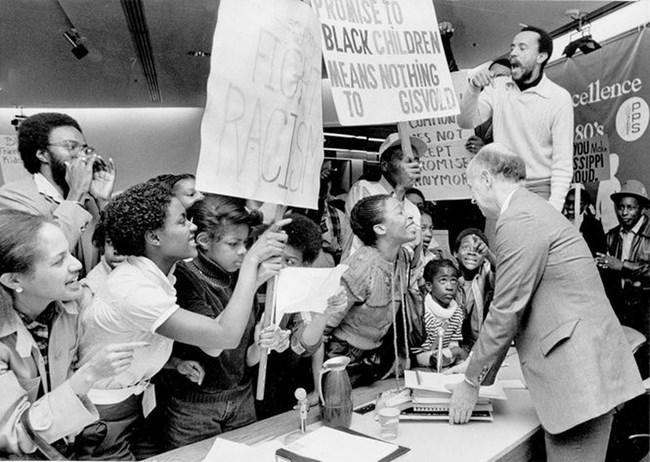Last updated: February 23, 2021
Article
Oregon: Racing to Change - Oregon's Civil Rights Years

Photographed by Steve Nehl. Oregon Historical Society Research Library, Oregon Journal Collection, digital image no. ba018353, copyright Oregonian Publishing Co.
Racing to Change: Oregon's Civil Rights Years connects to the stories of our national African American civil rights movement by showcasing the seldom told stories of how Oregon's Black community fought for equality. Visitors to the online exhibit encounter local touchstones to familiar narratives of the era.As large numbers of African Americans arrived in Portland for the first time to work in shipyards during WW2, they encountered a city that was hostile to their presence. Redlining prohibited Black residency in most of the city, leading to a population boom in Vanport, the largest public housing project in American history at the time.
This diverse working class town was Oregon's second largest city at the war's end, but the famous Vanport Flood of 1948 destroyed the town and left most Blacks homeless. Those that remained in Oregon settled in Albina, Portland's only neighborhood with large numbers of Black residency. In the 50's, Albina's jazz clubs, churches, and businesses helped Northeast Portland become the heart of Black Oregon. But, as racial inequality gained new attention in the South, Oregon's inequalities went largely unnoticed on a national level. In the 1960s, housing discrimination was rampant, white flight led to disinvesment in North and Northeast Portland, and the city tried and failed to pass a civil rights bill. The tense summer of 1968 saw days of police violence on protesting Black youth, and non-violent student activism gave way to chapters of more radical groups like the Black Panthers and the Black United Front.
Nonetheless, the accomplishments of Portland legal and social groups like the NAACP and Urban League helped lead to important new appointments. Mercedes Diez was elected to the Oregon Supreme Court, William Hillaird became editor of the Oregonian newspaper, and Ron Herndon fought for greater investment in majority Black schools.
Portland, the whitest major city in America, was transformed by the tireless efforts of a handful of Black community organizers whose resilience transformed the state forever. Their accomplishments are example that the African American civil rights movement was not reserved to the states with the largest Black populations, but a continuous pursuit of justice that took place wherever African American people were.
The Racing to Change: Oregon's Civil Rights Years digital exhibit became part of the African American Civil Rights Network in February 2021.
The African American Civil Rights Network recognizes the civil rights movement in the United States and the sacrifices made by those who fought against discrimination and segregation. Created by the African American Civil Rights Act of 2017, and coordinated by the National Park Service, the Network tells the stories of the people, places, and events of the U.S. civil rights movement through a collection of public and private elements.
